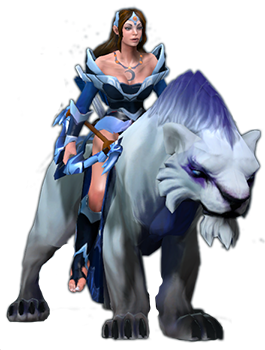Kill attempts: Sacred Arrow is a single target nuke/stun which makes it most useful for kill attempts. Generally, you want to start the fight with an Arrow, and if you are successful at hitting your target, follow up with the rest of your repertoire. The cooldown isn’t too long, so the spell is relatively spammable – you can afford to try your luck often. Because of the huge range, even if you miss, you lose nothing but some mana.
Scouting: The projectile gives 650 range flying vision. This is very useful when you want to check key positions like a high-ground choke point or the Rosh pit.
Farming: The arrow instantly kills creeps. This is the least flashy and the most important mechanic for the spell early on. You can use it to kill the big creep in a jungle camp to get additional resources – viable both from a long range if you are playing in the lane and want some additional gold, or from a short range if you want to farm the whole camp.
Efficient usage:
You get the full range and full stun just from one lvl. This is what makes the spell such a strong early game killing tool – if you land a long-range arrow, this will give you and your allies up to 5 seconds to hit the target with attacks.
The projectile is relatively slow, which means that it takes some time to travel the maximum 3k range. That’s why having someone to set up your arrow with a more reliable disable is the easiest way to ensure you’ll hit your target. If you attempt a long-range Arrow, it might be worth it to start running towards the target right when you shoot it. This way, if you hit, you will be closer to the target and ready to attack.
The stun scales with the range – the longer the range, the longer the stun duration. For every 150 distance traveled the stun increases with 0.5 seconds. Because of this, at 1500 range you get the maximum duration of 5 seconds, while at 300 range you get 1 second of stun. As a result, if your target is being held in one place (by another disable), it might be worth it to try to land a relatively long range Arrow. You need to bear in mind that the longer the range, the longer time it will take you to reach the target after you have shot the Arrow (the problem is solved if you have Leap). Sometimes, a short stun duration is all you need to finish the kill, and short-range Arrows are much harder to dodge.
The damage also scales with the distance but less dramatically than the stun (14 bonus damage per 150 range). You can get up to 140 bonus damage; however, the main portion of Sacred Arrow’s damage (not based on the distance) is dealt even from melee range. Because of this, if you want to use the Arrow more for the damage rather than the stun, it is smarter to shoot a short-range Arrow – it will deal most of the damage and at the same time, as we mentioned, it is much harder to dodge.
Aiming:
If you are shooting at a target which you expect to walk in a straight line with a normal MS of 350 and is currently approximately at 3k range from you, you need to shoot the Arrow at 1050 units in front of your target. For a target which is at 1500 range, this would be 525 units, for 750 range – 262.5 units, etc.
It is quite hard to hit a target when it is close to creeps - try to aim at isolated targets (e.g. lone ranged damage dealers) or groups of heroes to increase your chances.
Sacred Arrow hits invisible units – you can in theory snipe targets that are invisible or detect the movement of invisible heroes if your arrow hits them. The angle you are shooting at is also important – especially in the lane, it is easier to hit Arrows coming from the side rather than traveling along the lane because of the creeps.
When you attempt an Arrow, you must always bear in mind that the projectile is quite easy to dodge if seen. Consequently, obvious long-range Arrows are more often than not useless. You need to shoot the Arrow from a smart angle so that your opponent has very little time to react from the moment he/she sees it. If the Arrow travels over trees or a high ground (in the fog of war) before it reaches its target, it will be much harder to notice and as a result – dodge. Another thing to consider is the camera positioning of your target. For example, in the middle lane, the Dire mid laner usually has the camera moved a bit south-west in order to see the creeps and the opponent, while the hero is in the upper right end of the screen. Hence, if you shoot an Arrow from such an angle that it enters the screen of the Dire mid laner from the east (right) side, the player will have much less time to react. If you shoot the Arrow from the lane, on the other hand, dodging it will take almost no effort.
In general, players have their camera fixed on the action. In a fight, it is much easier to hit heroes with Arrows if you shoot from behind or the sides rather than from the direction of the fight.











